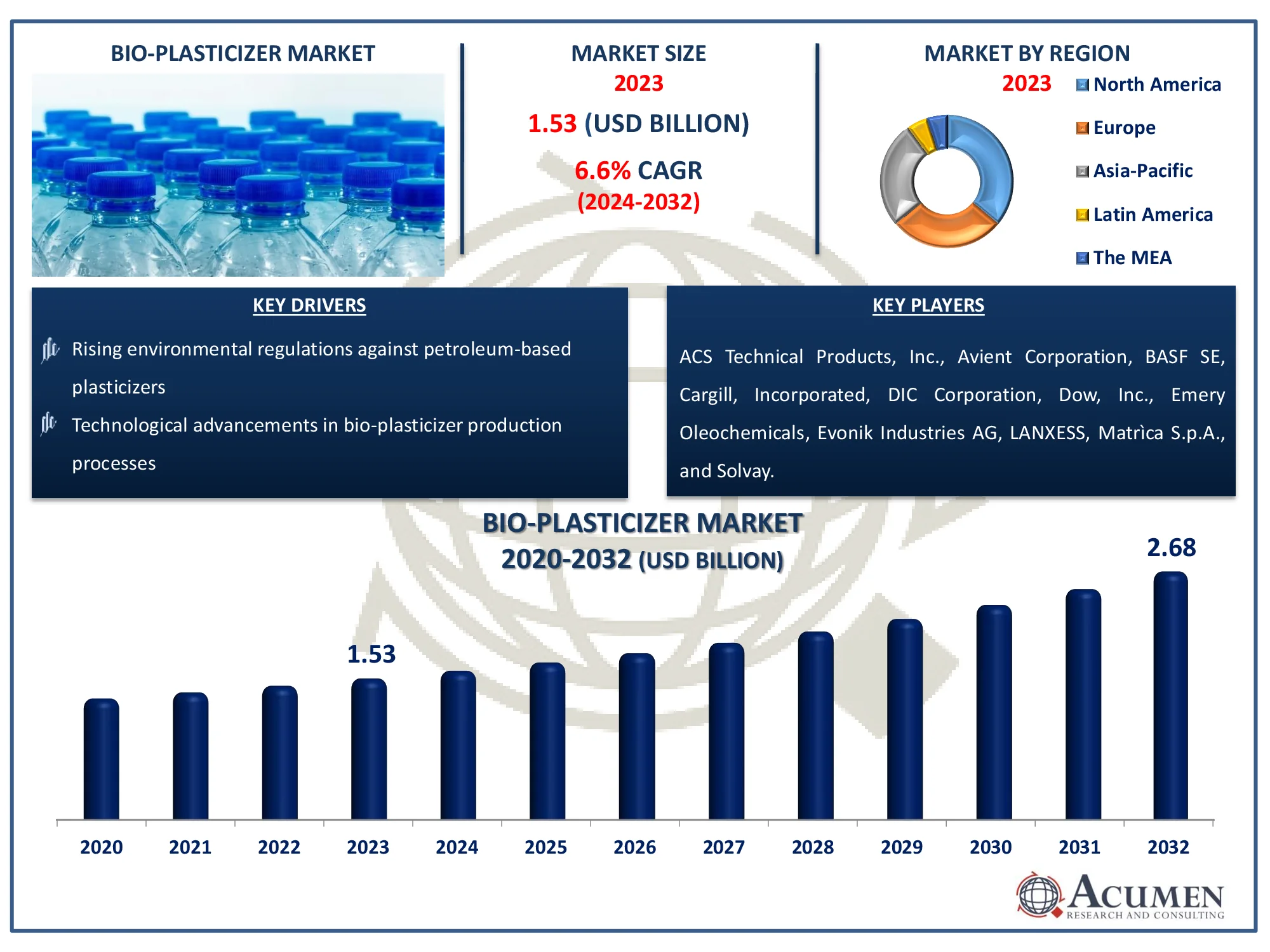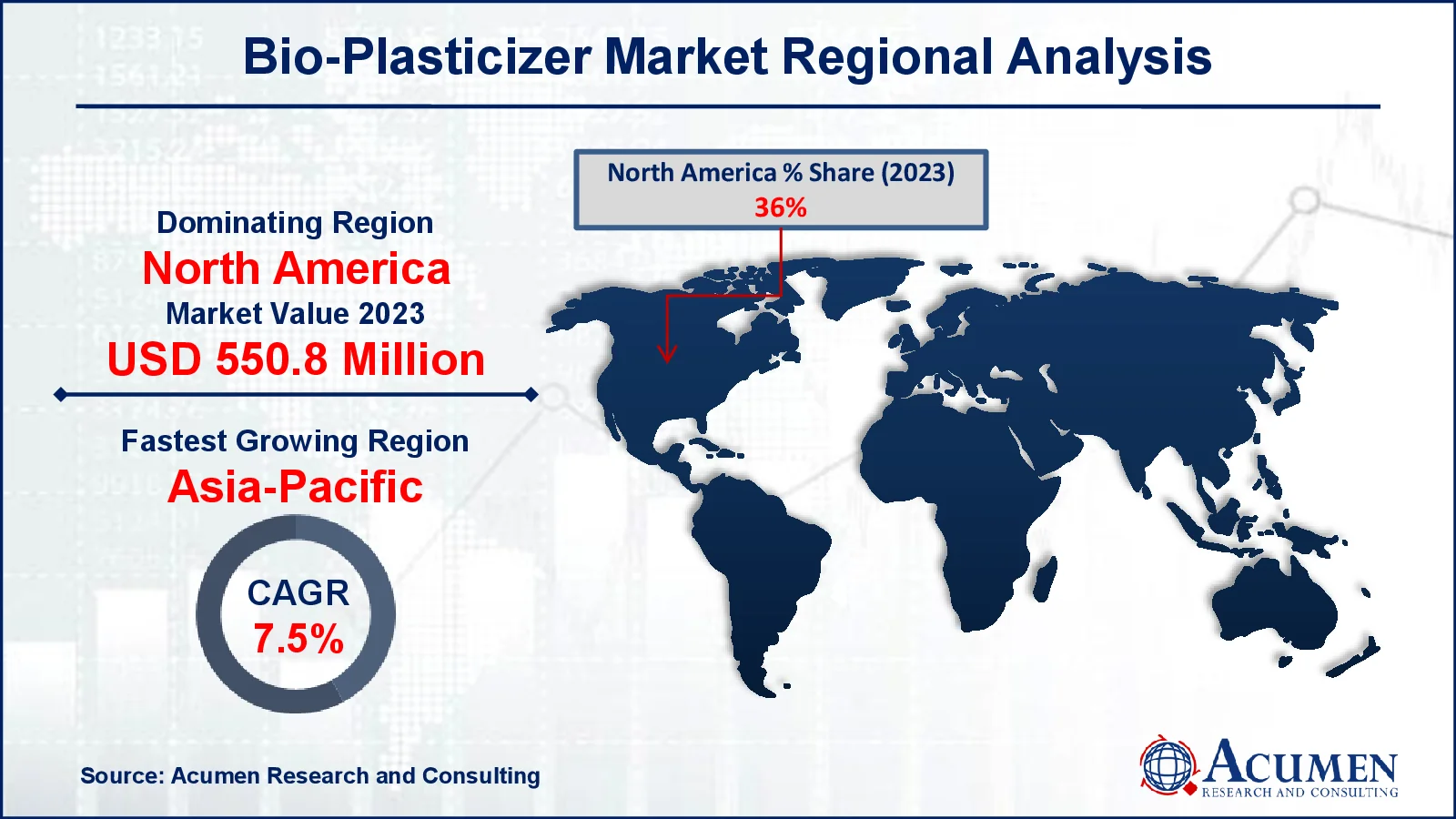Bio-Plasticizer Market Size - Global Industry, Share, Analysis, Trends and Forecast 2024 - 2032
Published :
Report ID:
Pages :
Format :
Bio-Plasticizer Market Size - Global Industry, Share, Analysis, Trends and Forecast 2024 - 2032
Report Coverage
- Industry Dynamics
- Market Size and Forecast Data
- Segment Analysis
- Competitive Landscape
- Regional Analysis with a Niche Focus on Country-Level Data
- High Level Analysis - Porter's, PESTEL, Value Chain, etc.
- Company Profiles of Key Players
- Option to Customize the Report As Per Your Specific Need
Request Sample Report
The Global Bio-Plasticizer Market Size accounted for USD 1.53 Billion in 2023 and is estimated to achieve a market size of USD 2.68 Billion by 2032 growing at a CAGR of 6.6% from 2024 to 2032.
Bio-Plasticizer Market Report Highlights:
- Global bio-plasticizer market revenue is poised to garner USD 2.68 billion by 2032 with a CAGR of 6.6% from 2024 to 2032
- North America bio-plasticizer market value occupied around USD 550.8 million in 2023
- Asia-Pacific bio-plasticizer market growth will record a CAGR of more than 7.5% from 2024 to 2032
- Among type, the epoxidized soybean oil (ESBO) sub-segment generated over US$ 535.5 million revenue in 2023
- Based on applications, the packaging materials sub-segment generated 33% bio-plasticizer share in 2023
- Growing partnerships between bio-plasticizer manufacturers and end-use industries for customized solutions is a popular market trend that fuels the industry demand

Bio-plasticizers are innovative compounds integrated into polymer matrices to enhance flexibility and improve the chemical properties of plastic products. Renowned for their superior biodegradability and minimal adverse chemical effects during degradation, bio-based plasticizers are increasingly favored over traditional options. They serve as vital additives in a variety of applications, including PVC resins, PVC cables, wire jacketing, vinyl flooring, and automotive parts. Notably, using bio-plasticizers in wire products enables OEMs and cable manufacturers to reduce carbon emissions by up to 40%.
Derived from vegetable raw materials like soybean oil, castor oil, starch, and palm oil, bio-plasticizers offer an eco-friendly alternative to petroleum-based counterparts. One prominent example is Epoxidized Soybean Oil (ESBO), produced through the epoxidation of soybean oil. ESBO is widely utilized as an additive in PVC gaskets, particularly in food packaging, due to its effectiveness and sustainability. Embracing bio-plasticizers not only supports environmental stewardship but also enhances the performance and safety of plastic products.
Global Bio-Plasticizer Market Dynamics
Market Drivers
- Increasing demand for eco-friendly and sustainable materials
- Rising environmental regulations against petroleum-based plasticizers
- Growing consumer awareness about the benefits of biodegradable products
- Technological advancements in bio-plasticizer production processes
Market Restraints
- Higher production costs compared to traditional plasticizers
- Limited availability of raw materials for bio-plasticizer production
- Variability in the performance of bio-plasticizers compared to synthetic alternatives
Market Opportunities
- Expanding applications in various industries such as automotive, construction, and packaging
- Development of cost-effective production methods for bio-plasticizers
- Increasing investment in research and development of new bio-plasticizer formulations
Bio-Plasticizer Market Report Coverage
|
Market |
Bio-Plasticizer Market |
|
Bio-Plasticizer Market Size 2023 |
USD 1.53 Billion |
|
Bio-Plasticizer Market Forecast 2032 |
USD 2.68 Billion |
|
Bio-Plasticizer Market CAGR During 2024 - 2032 |
6.6% |
|
Bio-Plasticizer Market Analysis Period |
2020 - 2032 |
|
Bio-Plasticizer Market Base Year |
2023 |
|
Bio-Plasticizer Market Forecast Data |
2024 - 2032 |
|
Segments Covered |
By Type, By Application, and By Geography |
|
Regional Scope |
North America, Europe, Asia Pacific, Latin America, and Middle East & Africa |
|
Key Companies Profiled Aviation |
ACS Technical Products, Inc., Avient Corporation, BASF SE, Cargill, Incorporated, DIC Corporation, Dow, Inc., Emery Oleochemicals, Evonik Industries AG, LANXESS, Matrìca S.p.A., and Solvay. |
|
Report Coverage |
Market Trends, Drivers, Restraints, Competitive Analysis, Player Profiling, Covid-19 Analysis, Regulation Analysis |
Bio-Plasticizer Market Insights
The global bio-plasticizer market has been gaining traction over the past few years due to the increasing need to shift towards sustainable ingredients. The wide range of applications for bio-plasticizers, such as in PVC, wire jacketing, medical equipment, automobile parts, vinyl flooring, packaging materials, and consumer goods, significantly drives the market's growth. This diverse usage is a major driver, as it showcases the versatility and essential role of bio-plasticizers across various industries. Rising health concerns among the population and stringent environmental regulations regarding carbon dioxide emissions further stimulate the demand for bio-plasticizers. These regulations are pushing industries to seek greener alternatives, making bio-plasticizers an attractive choice. This regulatory pressure acts as a catalyst for the market, ensuring continued interest and investment in bio-based solutions. Additionally, the improved characteristics of bio-plasticizers, such as enhanced flexibility, softness, workability, safety, non-phthalate composition, and increased biodegradability, support market growth. These benefits make bio-plasticizers a superior alternative to traditional plasticizers, attracting manufacturers aiming to produce safer and more environmentally friendly products. This shift towards better performance and safety standards is a significant driver, enhancing the market's appeal.
However, the market faces restraints as well. Higher production costs compared to traditional plasticizers can hinder the widespread adoption of bio-plasticizers. This cost factor is a major barrier, particularly for price-sensitive industries. Additionally, the limited availability of raw materials for bio-plasticizer production poses a challenge, potentially constraining supply and affecting market growth. Despite these restraints, the growing adoption of bio-based materials in various end-use industries is expected to propel the bio-plasticizer market forward. As more industries recognize the benefits of sustainable materials, the demand for bio-plasticizers is likely to increase, driving further growth and innovation in the market. Overall, the market's expansion is driven by the need for sustainability, regulatory pressures, and the superior properties of bio-plasticizers, though challenges related to cost and raw material availability remain.
Bio-Plasticizer Market Segmentation
The worldwide market for bio plasticizer market is split based on type, application, and geography.
Bio Plasticizers Market By Type
- Epoxidized Soybean Oil (ESBO)
- Castor Oil-Based Plasticizers
- Citrates
- Succinic acid
- Others
According to the bio-plasticizer industry analysis, the epoxidized soybean oil (ESBO) segment dominates the bio-plasticizer market due to its broad acceptance and exceptional properties. ESBO is produced from soybean oil using an epoxidation technique, which improves its stability and effectiveness as a plasticizer. It is particularly valued for its high compatibility with PVC, making it a popular choice for PVC resins, wire jacketing, and food packaging. Its great biodegradability, non-toxicity, and cost-effectiveness all contribute to its success. Furthermore, ESBO's capacity to improve the flexibility, durability, and safety of plastic products is consistent with the growing demand for eco-friendly and sustainable materials, resulting in a considerable market share in the bio-plasticizer sector.
Bio Plasticizers Market By Application
- Packaging Materials
- Automotive & Transport
- Textile
- Consumer Goods
- Medical Devices
- Wires & Cables
- Building & Construction
- Agriculture & Horticulture
- Others
The packaging materials segment is expected to take the largest share in the bio-plasticizer market due to the growing demand for sustainable and eco-friendly packaging solutions. With increasing consumer awareness and stringent environmental regulations, there is a significant shift towards biodegradable and non-toxic materials in packaging. Bio-plasticizers, particularly in packaging materials, enhance the flexibility, durability, and safety of plastics used for food packaging, containers, and films. This ensures compliance with health and safety standards while reducing the environmental impact. The surge in e-commerce and the need for efficient, sustainable packaging further drive the demand for bio-plasticizers in this segment. Their ability to maintain product integrity and extend shelf life while being environmentally friendly solidifies their dominance in the packaging materials market.
Bio-Plasticizer Market Regional Outlook
North America
- U.S.
- Canada
Europe
- U.K.
- Germany
- France
- Spain
- Rest of Europe
Asia-Pacific
- India
- Japan
- China
- Australia
- South Korea
- Rest of Asia-Pacific
Latin America
- Brazil
- Mexico
- Rest of LATAM
The Middle East & Africa
- South Africa
- GCC Countries
- Rest of the Middle East & Africa (ME&A)
Bio-Plasticizer Market Regional Analysis
In terms of bio plasticizer market analysis, North America has the largest and fastest expanding market, which is being driven by a number of major drivers. For starters, the region has a well-established infrastructure for producing and consuming bio-based products, which is backed up by stringent government rules and incentives that encourage sustainable practices. The United States and Canada are leaders in bio-plasticizer research and development, with large investments. This emphasis on innovation is helping to improve the quality and performance of bioplasticizers, allowing them to compete with traditional plasticizers. Furthermore, there is a high level of consumer awareness and demand for environmentally friendly products in North America, which is driving market expansion.

On the other hand, the Asia-Pacific region is seeing the highest development in the bio-plasticizer market, owing mostly to rising industrialization and urbanization. Countries such as China, India, and Japan are experiencing rising demand for bio-plasticizers as the automotive, packaging, and construction industries expand. The APAC region's enormous population and expanding middle class are driving increased purchase of consumer goods, many of which contain bioplasticizers. Furthermore, rising environmental consciousness and regulatory pressure to minimize carbon emissions are encouraging APAC businesses to use bio-based alternatives. The APAC area also benefits from the availability of raw ingredients like soybean oil and castor oil, which are required for bioplasticizer synthesis. Furthermore, the region's lower production costs make it an appealing industrial hub. Local governments and industry players are collaborating to promote sustainable practices and innovation in bio-plasticizer technology, which is further propelling market growth.
Bio-Plasticizer Market Players
Some of the top bio-plasticizer companies offered in our report includes ACS Technical Products, Avient Corporation, BASF SE, Cargill, Incorporated, DIC Corporation, Dow, Inc., Emery Oleochemicals, Evonik Industries AG, LANXESS, Matrìca S.p.A., and Solvay.
Frequently Asked Questions
How big is the market size of the global bio-plasticizer in 2023?
The bio-plasticizer market size was valued at USD 1.53 billion in 2023.
What is the CAGR of the global bio-plasticizer market from 2024 to 2032?
The CAGR of bio-plasticizer is 6.6% during the analysis period of 2024 to 2032.
Which are the key players in the bio-plasticizer market?
The key players operating in the global market are including ACS Technical Products, Avient Corporation, BASF SE, Cargill, Incorporated, DIC Corporation, Dow, Inc., Emery Oleochemicals, Evonik Industries AG, LANXESS, Matrìca S.p.A., and Solvay.
Which region dominated the global bio-plasticizer market share?
North America held the dominating position in bio-plasticizer industry during the analysis period of 2024 to 2032.
Which region registered fastest CAGR from 2024 to 2032?
Asia-Pacific region exhibited fastest growing CAGR for market of bio-plasticizer during the analysis period of 2024 to 2032.
What are the current trends and dynamics in the global bio-plasticizer industry?
The current trends and dynamics in the bio-plasticizer industry include rising fitness consciousness, increasing growth in endurance sports, growing convenience and portability demand, and expanding popularity of adventure sports and outdoor activities.
Which type held the maximum share in 2023?
The epoxidized soybean oil type held the maximum share of the bio-plasticizer industry.



